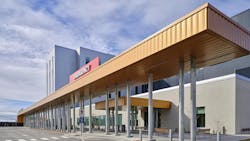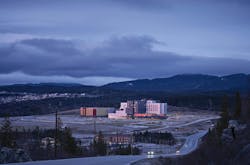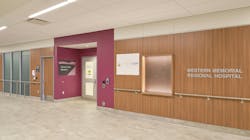How Canada’s Biggest Geothermal System Heats and Cools a Newfoundland Hospital
Western Memorial Regional Hospital in Corner Brook, Newfoundland, Canada, isn’t just a healthcare destination for patients across the province—it’s also a groundbreaking facility whose geothermal system is the largest of its kind in Canada, as well as the largest in a healthcare facility in North America.
The geothermal system—a closed-loop, vertical installation—provides 100% of the ground-source geothermal heating for the LEED Silver hospital and is located roughly 600 feet under the parking lot. Installing it allowed the design team to eliminate the need for cooling towers at the hospital, saving up to 2 million gallons of water per year.
Why Was Geothermal Specified?
The journey to geothermal began before the project was officially underway. “The Western Regional Health Authority published their project requirements and indicated that the use of fossil fuels was prohibited for heating,” explained Peter Kastelic, principal with engineering firm Smith + Andersen. “In Newfoundland, there are no natural gas pipelines or utility infrastructure—the typical approach in the region and province is electric resistance heating. Options for heating with fossil fuels would need to consider fuel delivery.”
Electricity would also pose a challenge, Kastelic added, because Newfoundland Power had a maximum feeder capacity before a complete infrastructure upgrade would become necessary. “Our initial investigations found that capturing the heating load of the boilers on electricity would push us over the cap and create a challenge with the utility service provider. Additionally, our heating system required a back-up power source, which would have required a massive emergency generator capacity. We needed a better option.”
Ground source heat pumps use as little as 25% of the peak power draw of electric boilers, Kastelic explained, making geothermal a highly attractive option.
When Geothermal Makes Sense for Healthcare
Healthcare facilities notoriously have high needs for both cooling and heating, depending on the space, explained Mark Berest, principal architect for design and consulting firm B+H Architects. Geothermal systems can serve these competing needs efficiently with minimal maintenance requirements.
“A geothermal heat pump system offers a significant increase in energy efficiency over traditional heating systems such as natural gas or electric resistance heating,” added Kastelic. “It also has an advantage over air source heat pump systems, which have outdoor equipment that is susceptible to weather and reduced performance in extremely cold days. Geothermal heat pump systems have all equipment indoors and underground, and benefit from a very stable operation all year round.”
Western Memorial’s system promises a 35% energy cost savings compared to the ASHRAE 90.1-2010 baseline and helped deliver 14 LEED points from the energy savings alone, contributing to the hospital’s LEED Silver target.
5 Challenges and Considerations in Using Geothermal for Healthcare
Geothermal doesn’t make sense for every building, or even every healthcare facility. Consider these five factors as you weigh heating and cooling options.
1. Consistent climates mean longer payback periods. “You don’t want to do [geothermal] in a consistent weather climate because it won’t really help you. You need big swings in seasonal temperatures for it to help you most efficiently,” Berest explained. “It can help you in other places, but the payback is much longer. It’s most efficient in cold weather climates or climates that have four seasons.”
The climate in Newfoundland and the building’s heating and cooling demands, which resulted in a nearly balanced annual load profile, fit this description, Kastelic said. “Ground energy balance is critical to longer-term performance and operational efficiency,” he added. “If the building load on the geothermal system is heating or cooling dominant, it can decrease performance and efficiency in the long term.”
2. Know your soil conditions. Drilling into rock is more difficult, but still possible.
3. Plan for heat recovery. Western Memorial’s geothermal system “operates in harmony with various heat recovery processes in the building,” Kastelic said. “This helps recycle heat within the building to reduce the amount of energy that has to be extracted or rejected to the ground. The system can tolerate short- and medium-term decreases in the heat recovery system performance, but long term would impact the ground energy balance and peak output capacity.”
4. Consider control strategies. Smith + Andersen included several controls strategies in Western Memorial’s system to help manage the geothermal field’s health if Newfoundland experiences an abnormally cold or hot year. “The facility operators must take care in monitoring the geothermal field energy profile on an annual basis to ensure the building automation system has been maintaining a balanced profile,” Kastelic said.
5. Factor in non-standard operating conditions. Designing a geothermal system for a healthcare facility requires careful consideration of things like system resiliency, failure modes, internal catastrophic events (such as smoke control or chemical spills), and pandemic catastrophic events (such as COVID-19 or other airborne illnesses).
“These operating modes can result in higher outdoor air conditioning load, reduced heat recovery, and a net increase in the geothermal load,” Kastelic said. “Through careful consideration of the peak load impacts of these systems and the duration and frequency of events, the impact on the geothermal system sizing and installation cost can be properly managed. Short duration events may not require an increase in geothermal field size, while longer duration events may impact the installation costs.”
Western Memorial Regional Hospital opened to patients and clients on June 2, 2024, providing a warm, patient-centered place to receive care.
“We’re proud of the hospital,” Berest said. “We’re really happy, and the community is happy with it. It delivered exactly what they needed, and at the end of the day, what they wanted.”
About the Author
Janelle Penny
Editor-in-Chief at BUILDINGS
Janelle Penny has been with BUILDINGS since 2010. She is a two-time FOLIO: Eddie award winner who aims to deliver practical, actionable content for building owners and facilities professionals.




